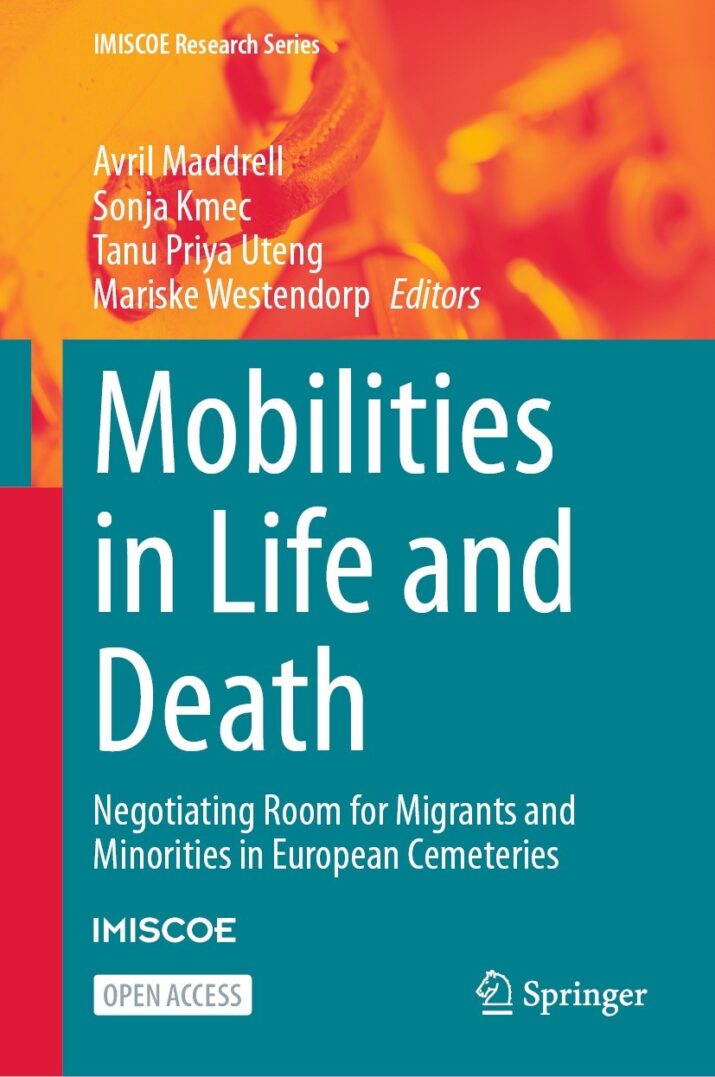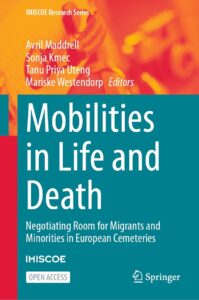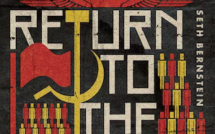
Mobilities in Life and Death: Negotiating Room for Migrants and Minorities in Europe edited by Avril Maddrell, Sonja Kmec, Tanu Priya Uteng, and Mariske Westendorpan

In the last fifteen years, Death Studies has seen a spatial turn: cultural geographers have introduced and explored the notion of “deathscapes.” This concept has provoked valuable new questions on the relationship between death and place. More recently, this theme has begun to consider the dynamics of movement and “displacement.” Mobilities in Life and Death is one of many outputs from a major HERA-funded project that examined the funeral practices of migrants and minorities in Europe. A core issue here is the degree to which national death infrastructures—particularly cemeteries and crematoria—are sufficiently flexible to allow for practices that may be regarded as ”non-normative.” This book draws together the experience of migrants and of minorities. For both groups, a key issue is whether freedom exists to express cultural identity and to honor religious imperatives at a highly symbolic moment.
The chapters deal with migrant groups that include Muslims and Hindus but also contain reference to Chinese migration and minority groups including the Jewish community and Travellers. With the exception of one chapter on Southern Italy, much of the text draws on fieldwork in Northern Europe where funerary culture has long roots in Christian tradition and where Christian symbolism is often built into historic funerary architecture. Indeed, across Scandinavia, the Lutheran churches still play a major role in the provision of funeral infrastructure. In France, by contrast, legislation has for more than two centuries defined a rigidly secular cemetery and crematorium provision. Here, the issue of minority rights has always carried a legalistic tone.
The tensions that are currently in evidence across Europe echo nineteenth-century kulturkampf: clashes between Christian denominations over theological distinctions and between Church and civil authorities over the sanctity of burial space. Now, conflict between Christian cultures has been replaced by non-Christian challenges to long-standing secularized management practices. The very nature of cemetery and crematorium professionalism connotes adherence to scientific, rational, and pragmatic principles. Resistance to the Hindu preference for open-air cremation is not based in objection to Hindu belief. Rather, open-air cremation carries environmental impacts from emissions that cannot be controlled without a filtration system. Perpetuity burial runs counter to a more sustainable system of grave re-reuse. Religious requirements in terms of grave alignment—towards Mecca or in accordance with feng shui principles—disturb cemetery plans that aim for an ordered maximization of grave spaces per hectare.
However, professional practice is increasingly recognizing the principles of cultural sensitivity and inclusivity. Much of this text offers evidence of genuine attempts by municipalities to accommodate difference. Chapter 2 describes developments in the UK in response to Hindu need: here, the authorities have arranged boat services for the scattering of cremated remains on the River Saur, which has been sanctified with water from the Ganges; crematoria are now more likely to have viewing rooms for the family to witness the body being charged into the cremator. It is notable that in Dundee, where the jute industry has created a long-standing connection between the city and Bangladesh, minority need was first recognized in the nineteenth century.
Admittedly, policy moves slowly, but then need is not always immediately evident. Christoph Jeden’s chapter, outlining very different contexts and patterns of migration, is a reminder that not all migrants want to settle. Seasonal labor markets create waves of movement. When young migrants do seek to make a new home, it takes a couple of decades before any thought is given to funeral practices. The weight of demand can accrue gradually, and policy movement in relation to funerary infrastructure is notoriously slow, irrespective of the nature of need. It can take many years to establish a new cemetery or build a new crematorium, which requires a long search for suitable land that meets environmental safeguards, is accessible in terms of public transport, and passes planning permission.
However, understanding municipal stakeholders’ perspectives does not negate the fact that migrants and minority groups can experience acute spiritual and emotional pain if their funerary needs are not met. Here it might be expected that these chapters contribute valuable empirical material. The stated methods indicate interviews with individuals and groups of migrants, but chapters are a little theory-heavy and evidence light. There is limited direct testimony on the impact of restrictive measures and a stronger reliance on minority group representatives. Pragmatically, the latter is an altogether easier group to engage in qualitative research, but stakeholders—in every sphere—tend to convey a particular kind of fixed ideal that does not always represent the messy reality of the constituencies they represent. A minister can list theological precepts but cannot comment on what each member of the congregation believes or how each will draw comfort in the event of a death. The history of funeral practice invariably sits within professional documents and stakeholder statement. It is often shaped by lobbyists who avidly promote an ideal and denigrate an extreme and distorted representation of the reality they are rejecting. These narratives do not often include direct evidence of lay belief or detailed descriptions of quotidian experiences.
The overarching argument of these chapters would have been strengthened if a greater number of voices of individual migrants had been included, as they described for example their journeys in all senses of the term; the impact of migration on their sense of identity; their reception in a new “home” country; the practices and deathscapes they have left behind; their opinions about the foreign funerary deathscapes in which they are required to express their loss; the degree of affordances for non-normative practice; and whether and how they seek to reshape those deathscapes for themselves through negotiation and compromise. There are some direct quotations, but the text contains few stories that capture and convey the migrant experience.
Funerary expression is in every context essentially dynamic. It may well be the case that the practices of migrants away from home are rather more fixed than in the locations from which they migrate. For example, cremation processes are changing in India to reduce environmental impacts in terms of wood consumption and emissions, and the fast pace of modern life is increasingly simplifying and compressing the more complex chronology of traditional commemorative rituals. The book here offers evidence that some people actively choose from the new options available to them: for example, the very fluid nature of Jewish expression does not always favor strictly Orthodox practices. Indeed, “there is a tension between the commitment to Jewish tradition and individual agency in burial choices” (131). Muslim funerary culture reflects ethnic preferences rather than theological imperatives, particularly with regard to the degree of elaboration in grave furniture. The volume shows that over time, people who hold strong religious views sometimes adapt to changing circumstances. For example, a Luxembourgish Imam contemplating grave re-use expressed laxity on the issue of perpetuity burial, concluding that the grave is only necessary for “as long as the body needs to decompose” (59).
Discussion of migrant funerary practices often presumes that the “home” nation has a settled and homogeneous funerary culture, where the practices of migrants might be viewed as an unwelcome disruption. In actuality, even in communities where diversity in ethnicity is almost entirely absent, burial and cemetery spaces are highly contested locations where some practices are regarded as deviant and resistance to restrictions is endemic. Several contributors in the book refer to lawn cemeteries where the size of headstones is limited and the demarcation of graves—with a small fence, kerbsets, or a slab—is not permitted. Nevertheless, families still do place “non-regulation” ephemera, particularly on children’s graves. Policing deathscapes is a constant management headache. The book evidences practices that affect all users. Everyone is subject to crematoria services that are sliced into narrow time slots. “Fairness” in affording all families the same—albeit limited—opportunities can be felt as disadvantageous by anyone whose preference might be for more elaborate funerals or more expansive commemorative expression. To say that regulations fall harder on particular ethnic groups intimates a hierarchy of grief. Everyone who seeks non-normative expression, for whatever reason, feels the impact of limitations as an unjustified assault.
Applying social justice principles to funerary practice indicates that services should demonstrate due cultural sensitivity but also be environmentally sustainable. All members of society, irrespective of culture or belief, will have to embrace funerary practices that move towards “net zero,” and this will mean a reduction in levels of consumption. Open-air cremation with no emissions control, land-hungry burial in perpetuity, and the quarrying and transportation of stone from across the globe to furnish graves all run counter to net zero objectives, but each of these practices connotes a high level of respect for the dead. This book does not consider how we might begin to address this acutely painful ethical dilemma.
Julie Rugg is a reader in social policy in the School for Business and Society at the University of York. She has published extensively on the subject of funerary practices historically and from a policy perspective. She is editor of the Routledge series “International Focus on Death and Funeral Practices” and has published recently on social justice and cemetery systems and on funerary heritage.
Mobilities in Life and Death: Negotiating Room for Migrants and Minorities in European Cemeteries
Edited by Avril Maddrell, Sonja Kmec, Tanu Priya Uteng and Mariske Westendorp
Publisher: Springer
Hardcover / 220 pages / 2023
ISBN: 978-3-031-28283-6
Published on September 12, 2023.




